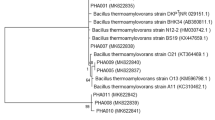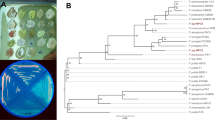Abstract
Three strains of Pseudomonas (P.) bacteria were screened for their capabilities of degrading chemically synthesized saturated branched-chain fatty acids (sbc–FA). Mixtures of sbc–FA with the methyl-branch located at various locales along the fatty acid were used as a carbon feedstock in shake-flask culture. Utilization (and hence degradability) of the sbc–FA was monitored based on positive bacterial growth, fatty acid recovery rates and chromatographic (gas chromatography (GC) and GC-mass spectroscopy (MS)) analysis of the recovered carbon source. P. putida KT2442 and P. oleovorans NRRL B-14683 were both able to grow on sbc–FA utilizing 35 wt% and 27 wt% of the carbon source, respectively after 144 h. In contrast, P. resinovorans NRRL B-2649 exhibited the most efficient use of the carbon source by utilizing 89 % of the starting material after 96 h resulting in a cell dry weight (CDW) of 3.1 g/L. GC and GC–MS analysis of the recovered carbon source revealed that the bacterial strains selectively utilized the isostearic acid in the sbc–FA mixture, and a new group of C10, C12, C14 and C16-linear and/or branched-chain fatty acids (approximately 4–29 wt%) were formed during degradation.





Similar content being viewed by others
References
Korfmacher WA, Wehry EL, Mamantov G, Natusch DFS (1980) Resistance to photochemical decomposition of polycyclic aromatic hydrocarbons vapor-adsorbed on coal fly ash. Environ Sci Technol 14:1094–1099
Tagawa S (1986) Pulse radiolysis and laser photolysis studies on radiation resistance and sensitivity of polystyrene and related polymers. Radiat Phys Chem 27:455–459
Guebitz GM, Cavaco-Paulo A (2008) Enzymes go big; surface hydrolysis and functionalization of synthetic polymers. Tends Biotechnol 26:32–38
Harding KG, Dennis JS, von Blottnitz H, Harrison STL (2007) Environmental analysis of plastic production processes: comparing petroleum-based polypropylene and polyethylene with biologically based poly-β-hydroxybutyric acid using life cycle analysis. J Biotechnol 130:57–66
ASTM standardization news what’s next for biodegradable and compostable plastics? http://www.astm.org/SNEWS/APRIL_2001/mojo_apr01.html.(accessed May 2012)
Vincotte requirements of the EN 13432 standard. http://www.okcompost.be/data/pdf-document/Doc-09e-a-Requirements-of-norm-EN-13432.pdf (accessed May 2012)
International Organization for Standardization ISO 17088:2008 http://www.iso.org/iso/catalogue_detail.htm?csnumber=43373 (accessed May 2012)
Salimon J, Salih N, Yousif E (2010) Biolubricants: raw materials, chemical modifications and environmental benefits. Eur J Lipid Sci Technol 112:519–530
Lee S-H, Wang S (2006) Biodegradable polymers/bamboo fiber biocomposite with bio-based coupling agent. Composites part A: Appl Sci Manu 37:80–91
Xie H, King A, Kilpelainen I, Granstrom M, Argyropoulos DS (2007) Thorough chemical modification of wood-based lignocellulosic materials in ionic liquids. Biomacromolecules 8:3740–3748
Hazer B, Steinbuchel A (2007) Increased diversification of polyhydroxyalkanoates by modification reactions for industrial and medical applications. Appl Microbiol Biotechnol 74:1–12
Zinn M, Hany R (2005) Tailored material properties of polyhydroxyalkanoates through biosynthesis and chemical modification. Adv Environ Mater 7:408–411
Casteels M, Foulon V, Mannaerts GP, Van Veldhoven PP (2003) Alpha-oxidation of 3-methyl-substituted fatty acids and its thiamine dependence. Eur J Biochem 270:1619–1627
Wanders RJA, Ferdinandusse S, Brites P, Kemp S (2010) Peroxisomes, lipid metabolism and lipotoxicity. Biochim Biophys Acta 1801:272–280
Thijsse GJE, Zwilling-De Vries JT (1959) The oxidation of straight and branched alkanes by Pseudomonas strains. Antonie Van Leeuwenhoek 25:332–336
Lau EP, Gibson KM, Fall RR (1980) Alternate microbial strategies for the metabolism of a 3-methyl branched alkanoic acid. Curr Microbiol 4:163–167
Ngo HL, Foglia TA, Nuñez A, Lin W (2007) Zeolite-catalyzed isomerization of oleic acid to branched-chain isomers. Eur J Lipid Sci Technol 108:214–224
Ngo, HL, Hoh, E, Foglia, TA (2011) Improved synthesis and characterization of saturated branched-chain fatty acid isomers Eur J Lipid Sci Technol. In press
Tomifuji T, Abe Y, Matsumua Y, Sakuma Y (1997) Process for the preparation of branched chain fatty acids and alkyl esters thereof. US Patent 5(677):473
Zhang Z, Dery M, Zhang S, Steichen D (2004) New process for the production of branched-chain fatty acids. J Surf Detergents 7:211–215
Zhang S, Zhang Z, Steichen D (2005) Skeletal isomerization of alkyl esters and derivatives prepared there from. US Patent 6(946):567
Ngo HL, Dunn RO, Sharma B, Foglia TA (2011) Synthesis and physical properties of isostearic acids and their esters. Eur J Lipid Sci Technol 113:180–188
Ashby RD, Ngo HL, Solaiman DKY, Strahan G (2009) Methyl-branched poly(hydroxyalkanoate) biosynthesis from 13-methyltetradecanoic acid and mixed isostearic acid isomer substrates. Appl Microbiol Biotechnol 85:359–370
Ashby RD, Solaiman DKY, Foglia TA (2002) Poly(ethylene glycol)-mediated molar mass control of short-chain and medium-chain-length poly(hydroxyalkanoates) from Pseudomonas oleovorans. Appl Microbiol Biotechnol 60:154–159
Huijberts GNM, de Rijk TC, de Waard P, Eggink G (1994) 13C nuclear magnetic resonance studies of Pseudomonas putida fatty acid metabolic routes involved in poly(3-hydroxyalkanoate) synthesis. J Bacteriol 176:1661–1666
Holm T (1999) Aspects of the mechanism of the flame ionization detector. J Chromatogr A 842:221–227
Dodds ED, McCoy MR, Rea LD, Kennish JM (2005) Gas chromatographic quantification of fatty acid methyl esters: flame ionization detection vs electron impact mass spectrometry. Lipids 40:419–428
Ashby RD, Solaiman DKY, Foglia TA, Liu CK (2001) Glucose/lipid mixed substrates as a means of controlling the properties of medium chain length poly(hydroxyalkanoates). Biomacromolecules 2:211–216
Brandl H, Gross RA, Lenz RW, Fuller RC (1988) Pseudomonas oleovorans as a source of poly(β-hydroxyalkanoates) for potential applications as biodegradable polyesters. Appl Environ Microbiol 54:1977–1982
Acknowledgments
We thank Mr. Kerby Jones for help on the analytical procedures used in this study. We thank Mr. Bun Hung Lai and Ms. Heather Vanselous for experimental help.
Author information
Authors and Affiliations
Corresponding author
Additional information
H. L. Ngo and R. D. Ashby contributed equally to this work.
Mention of trade names or commercial products in this publication is solely for the purpose of providing specific information, and does not imply recommendation or endorsement by the U.S. Department of Agriculture.
USDA is an equal opportunity provider and employer.
About this article
Cite this article
Ngo, H.L., Ashby, R.D. & Nuñez, A. Selective Microbial Degradation of Saturated Methyl Branched-Chain Fatty Acid Isomers. J Am Oil Chem Soc 89, 1885–1893 (2012). https://doi.org/10.1007/s11746-012-2092-0
Received:
Revised:
Accepted:
Published:
Issue Date:
DOI: https://doi.org/10.1007/s11746-012-2092-0




